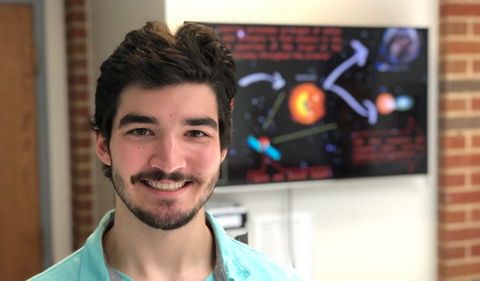By William Eshbaugh
(B.S. Applied Physics, College of Arts & Sciences, Class of 2020)
Editor’s Note: Experiment E12-13-010 at Jefferson National Laboratory will measure the probability of an electron inducing the radiation of a photon by a proton in kinematic regimes previously unexplored. To do so, a new detector is being developed and will be placed close by the liquid hydrogen target and will operate in a radiation harsh environment. Over a thousand of high voltage dividers that will power that detector are being assembled at Ohio University. Working under the direction of Dr. Julie Roche, William built a stand at Edwards Accelerator Lab that will allow researchers to test each of these dividers.
My internship was really an introduction to the world of nuclear/particle physics. I worked on the experimental setup that will be used to test the high voltage dividers as well as the actual testing of them. They are specially designed to power photomultiplier tubes (PMT’s) and will be used in the construction of the Neutral Particle Spectrometer (NPS) in Hall C at Jefferson National Lab (JLab). In general, the internship gave me an idea of what it was like to work in this field of physics. I learned the basics of ROOT, a C++ based software from CERN designed for big data processing and statistical analysis. At the start of the internship, I needed to read about the equipment being used like PMT’s and HV dividers and understand how they function. I also learned how to solder so that I could assemble the HV cables.
I have been honing my problem solving, communication, and programming skills at Edwards Accelerator Lab. I had to coordinate meeting times with the 3D printing lab team, electronics shop, and other faculty members. Learning ROOT and analyzing collected data improved my programming abilities. It definitely helped me to be among experienced physicists and engineers that could offer me advice when needed.
The biggest challenge to conceptualize/improve the box was the process of designing the concepts for the 3D printed equipment. I brought my concepts (rough drawings on paper) and met with the 3D printing lab in the Innovation Center multiple times to review the designs and have the designers create it on CAD software. However, another equally challenging task was setting up the communication between the computer and oscilloscope so that the data can be collected automatically. Finding and installing the software was only accomplished after researching oscilloscopes and their compatible software(which also had to work on my computer).
There were phone meetings with others working on the NPS project and the DVCS (Deeply Virtual Compton Scattering) experiment where individuals presented their current progress. We also had weekly intern meetings where Dr. Roche and her interns would present their internship progress/future goals. She was there most of the time, so I would occasionally meet to ask questions and plan what I should be doing next.
JLab was one of the most interesting places I have been. It was a three-day trip, but Day 1 and 3 were traveling there and back. Dr. Roche gave us a tour of the facilities and explained what the accelerator equipment was and how it worked. We also attended some of the relevant meetings they had scheduled during our visit. The size of the facility was massive and quite an experience that not everyone will have.
This internship opportunity intrigued me because it included a more hands-on/experimental aspect rather than just plain data analysis. However, I do enjoy computer science and using ROOT to analyze any data I collected was still interesting. More importantly, having equipment to “play” with and design/assemble was what attracted me.
The high voltage dividers are going to be used in the Neutral Particle Spectrometer (NPS), and they can be difficult to remove once they are in place. Therefore, we need to make sure they are all working properly…all 1,170 of them. When parts of your detector fail and need replaced, it will slow things down and reduce the amount of time you can run your experiment. Everyone has a limited amount of time using the accelerator, so using the time efficiently is important.
I plan to return during fall semester to finish what I started, and it was a great experience!





















Comments